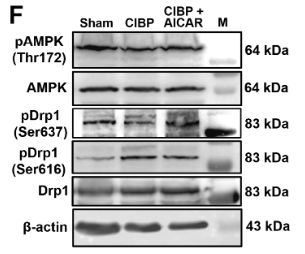TRAP1 Antibody - #DF7073
| Product: | TRAP1 Antibody |
| Catalog: | DF7073 |
| Description: | Rabbit polyclonal antibody to TRAP1 |
| Application: | WB IHC IF/ICC |
| Cited expt.: | WB, IF/ICC |
| Reactivity: | Human, Mouse, Rat |
| Prediction: | Pig, Zebrafish, Bovine, Horse, Sheep, Dog, Chicken, Xenopus |
| Mol.Wt.: | 80kDa; 80kD(Calculated). |
| Uniprot: | Q12931 |
| RRID: | AB_2839029 |
Related Downloads
Protocols
Product Info
*The optimal dilutions should be determined by the end user. For optimal experimental results, antibody reuse is not recommended.
*Tips:
WB: For western blot detection of denatured protein samples. IHC: For immunohistochemical detection of paraffin sections (IHC-p) or frozen sections (IHC-f) of tissue samples. IF/ICC: For immunofluorescence detection of cell samples. ELISA(peptide): For ELISA detection of antigenic peptide.
Cite Format: Affinity Biosciences Cat# DF7073, RRID:AB_2839029.
Fold/Unfold
Heat shock protein 75 kDa; Heat shock protein 75 kDa, mitochondrial; HSP 75; HSP75; HSP90L; mitochondrial; TNF receptor associated protein 1; TNFR-associated protein 1; TRAP-1; Trap1; TRAP1_HUMAN; Tumor necrosis factor type 1 receptor-associated protein;
Immunogens
A synthesized peptide derived from human TRAP1, corresponding to a region within the internal amino acids.
Found in skeletal muscle, liver, heart, brain, kidney, pancreas, lung, placenta and bladder. Expression is highly reduced in bladder cancer and renal cell carcinoma specimens compared to healthy tissues, but it is increased in other type of tumors.
- Q12931 TRAP1_HUMAN:
- Protein BLAST With
- NCBI/
- ExPASy/
- Uniprot
MARELRALLLWGRRLRPLLRAPALAAVPGGKPILCPRRTTAQLGPRRNPAWSLQAGRLFSTQTAEDKEEPLHSIISSTESVQGSTSKHEFQAETKKLLDIVARSLYSEKEVFIRELISNASDALEKLRHKLVSDGQALPEMEIHLQTNAEKGTITIQDTGIGMTQEELVSNLGTIARSGSKAFLDALQNQAEASSKIIGQFGVGFYSAFMVADRVEVYSRSAAPGSLGYQWLSDGSGVFEIAEASGVRTGTKIIIHLKSDCKEFSSEARVRDVVTKYSNFVSFPLYLNGRRMNTLQAIWMMDPKDVREWQHEEFYRYVAQAHDKPRYTLHYKTDAPLNIRSIFYVPDMKPSMFDVSRELGSSVALYSRKVLIQTKATDILPKWLRFIRGVVDSEDIPLNLSRELLQESALIRKLRDVLQQRLIKFFIDQSKKDAEKYAKFFEDYGLFMREGIVTATEQEVKEDIAKLLRYESSALPSGQLTSLSEYASRMRAGTRNIYYLCAPNRHLAEHSPYYEAMKKKDTEVLFCFEQFDELTLLHLREFDKKKLISVETDIVVDHYKEEKFEDRSPAAECLSEKETEELMAWMRNVLGSRVTNVKVTLRLDTHPAMVTVLEMGAARHFLRMQQLAKTQEERAQLLQPTLEINPRHALIKKLNQLRASEPGLAQLLVDQIYENAMIAAGLVDDPRAMVGRLNELLVKALERH
Predictions
Score>80(red) has high confidence and is suggested to be used for WB detection. *The prediction model is mainly based on the alignment of immunogen sequences, the results are for reference only, not as the basis of quality assurance.
High(score>80) Medium(80>score>50) Low(score<50) No confidence
Research Backgrounds
Chaperone that expresses an ATPase activity. Involved in maintaining mitochondrial function and polarization, downstream of PINK1 and mitochondrial complex I. Is a negative regulator of mitochondrial respiration able to modulate the balance between oxidative phosphorylation and aerobic glycolysis. The impact of TRAP1 on mitochondrial respiration is probably mediated by modulation of mitochondrial SRC and inhibition of SDHA.
Mitochondrion. Mitochondrion inner membrane. Mitochondrion matrix.
Found in skeletal muscle, liver, heart, brain, kidney, pancreas, lung, placenta and bladder. Expression is highly reduced in bladder cancer and renal cell carcinoma specimens compared to healthy tissues, but it is increased in other type of tumors.
Belongs to the heat shock protein 90 family.
References
Application: IF/ICC Species: Rat Sample: spinal cord
Application: WB Species: Rat Sample: spinal cord
Restrictive clause
Affinity Biosciences tests all products strictly. Citations are provided as a resource for additional applications that have not been validated by Affinity Biosciences. Please choose the appropriate format for each application and consult Materials and Methods sections for additional details about the use of any product in these publications.
For Research Use Only.
Not for use in diagnostic or therapeutic procedures. Not for resale. Not for distribution without written consent. Affinity Biosciences will not be held responsible for patent infringement or other violations that may occur with the use of our products. Affinity Biosciences, Affinity Biosciences Logo and all other trademarks are the property of Affinity Biosciences LTD.









